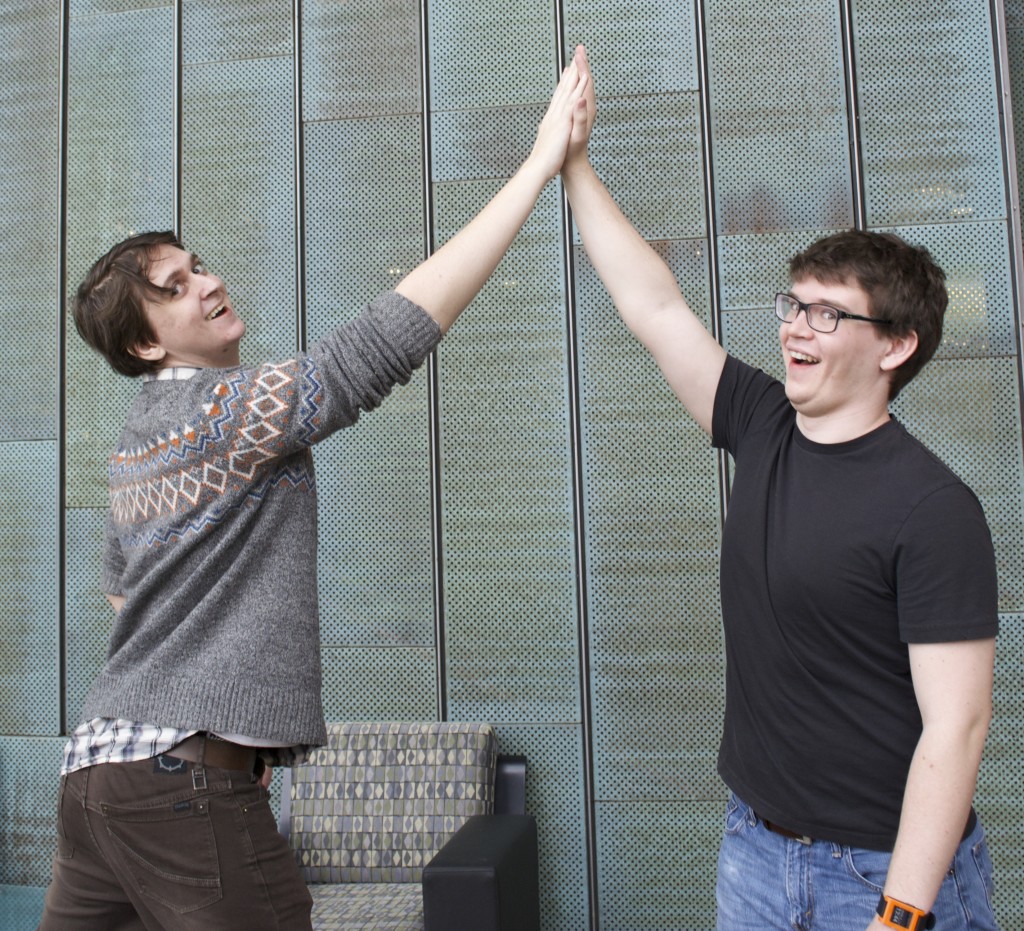It has often been said, that filling out a Y Combinator application is an excellent way to gain perspective about your startup, regardless of making it to interviews. Although I wouldn’t argue with that, I’m here to inform you that building a Kickstarter has (at least for us) helped far more.
To put this in perspective, we have applied to Y Combinator before and it took us a week or so to hammer everything down, and even then we were declined. After building a Kickstarter, it took us less than 24 hours to fill everything out, it was concise, and we will see if we are accepted to the YC S15 batch, but we feel our application has improved significantly.
More importantly, we have been emotionally hardened in the process. We have gained a ton of skills, and are capable of handling failure, success, and everything else that comes along with building a company.
For Robb, Jenny, Cole, and I, the first logical step in creating Synaptitude (apart from applying to Y Combinator) was launching a successful Kickstarter.
Our Kickstarter is called ThinkSuite!
Assuming we launch a successful Kickstarter we ensure three things,
- We have a viable market
- That market is fairly large
- Our idea is sellable to said market
This helps us avoid going down a path of a bad idea, but also helps us build far quicker if we have a good one. By obtaining customers prior to actually launching we are already way ahead of most startups, hopefully leading to connections, and better/higher funding offers.
On the other hand, building a decent Kickstarter is a ton of work, and there is probably only a 50% chance of success. In our case, the chance of success is perhaps even lower, given it was software (a statistically much lower success rate on Kickstarter), and required a several hundred dollar investment.
This article is my reflection of what I have learned building a Kickstarter, and what I wish others had told me. This article does not all the technical details about building a successful Kickstarter, that will be saved for a separate article. This article focuses on the personal growth, and what I wished someone had told me before I started.
Building a Kickstarter: Time Investment
To put the amount of work in perspective, let’s break out how much time I put into the Kickstarter:
- Researching Idea: 250 hours
- Building Prototype(s): 400 hours
- Building Mockup(s): 15 hours
- Creating Website: 70 hours
- Making Video + Photos: 47 hours
- Creating Ad Strategy: 8 hours
- Making Contacts: 20 hours
- Executing Ad Strategy: 140 hours
Total: 960 hours
I first began researching the idea in February 2014 (12 months prior to the Kickstarter), and since have put in 20+ hours a week. Throughout the year I have also been a full-time student, full-time employee for Capital One, and then a part-time employee of Caterpillar and full-time student.
In other words, it’s been extraordinarily difficult to work on the Kickstarter. It is very time consuming and if you have other responsibilities, plan to have no free time.
Building a Kickstarter: Financial Considerations
Prior to building our Kickstarter, I spent a large amount time researching how to be successful. What surprised me was how much money most people invest in their Kickstarter.

Even our team, which attempted to avoid spending as much money as we could, still spent a fair amount on advertisements:
- Facebook: $230
- AdWords (Google): $100
- Bing (Micosoft): $50
- Twitter: $50
- HabitRPG: $100
- Initial Funding: $400
Total: $930
Of the amount we spent, JustHost.com provided $230 in coupons (our web-hosting company), and $400 we get back if the Kickstarter fails or 10% less if successful. That means our total advertising investments (if our Kickstarter fails) $300.
Beyond advertising, we purchased a refurbished Nikon D5200 + lens for ~$500, originally ~$980. The camera was something we previously were considering, but we would have not purchased one nearly as nice, had it not been for the Kickstarter.
We managed to avoid spending virtually anything else, by simply designing everything ourselves (plus a friend and designer Vincent Chang). Whether or not this impacted our Kickstarter has yet to be seen, but I feel our product is less about design and more about functionality. Though a nice design definitely raises more funds, I feel our designs were “decent enough.”
Building a Kickstarter: Emotional Investment
Pouring all your free time into building something without any guarantee (perhaps even a losing probability) of success, can be highly stressful. Not very hard to image, placing so much effort into something and potentially failing can be hard.
This is not always the case, for example the Exploding Kittens Kickstarter probably took (my uninformed estimate) ~500 hours, given there was little-to-no coding and scientific research involved. In all honesty, I’m jealous I didn’t come up with the idea.
While I (and I am sure others) work on a Kickstarter a feeling of self-worth begins to be tied with the Kickstarter success or failure. I know I have learned a ton, and even if the Kickstarter fails the work will not be in vain. However, it doesn’t help the emotional turmoil.
If you plan to create a Kickstarter, be sure to have an iron stomach, and try to stay positive. Remember, a failure of a Kickstarter is not necessarily a rejection of the idea by the masses. Rather, the Kickstarter clientele may not be your target market.
Building a Kickstarter: Opportunity Cost
Beyond the time, financial, and emotional considerations, it should be noted that every investment you make has an infinitely large opportunity cost. For example, I could have graduated a semester earlier, saving ~$15,000, and began working. However, I chose to work part time, take a lighter school load (12 – 14 credit hours), and build some really (in my opinion) amazing software.
This leads me to bestow some unrequested advise. In order to “feel good” at the end of the Kickstarter (success or failure), make sure you grow. I know that I have learned oodles about advertising/marketing, video creation, design, software development (especially Qt), EEG technology, and neuroscience.
Regardless of the success or failure of ThinkSuite I know I will likely launch another Kickstarter (perhaps to fund my introduction and fun algorithms). I have gained a breadth of skills that could help in building a Kickstarter, for myself and others. In other words, I feel building a Kickstarter was worth the opportunity cost, and it’s much better than just going out and partying (as many students do senior year of college).
Building a Kickstarter: Benefits
I actually think building a Kickstarter was one of the more fun and rewarding experiences during my college years.

Not only did I learn more than I ever imagined about how to present a company to others (I have small business ventures, but usually I had the attitude, “build it and they will come”). In this case, I literally had to learn to pitch and idea, rather than present something immediately useful.
Rather than trading value, I am attempting to convince a largely less educated audience (less educated in my area of research) that my theories hold and it is worth them spending $300 – $1000 on an unconstructed software package. Putting it in that manner, really made me think about what I was doing. In the end, I knew that if someone offered what I was going to build I would buy it. The challenge being, I had to describe, and sell my vision to others.
Learning to describe my vision has been the greatest benefit when building a Kickstarter. Every time I used to post an article, talk about the idea, or show people the application(s), all my readers/friends would doubt that it worked. I had to learn how to present the information/support in an easy to understand manner, then convince them that “I am their man.”
Clearly, I am still learning this skill, but it is something I never really thought I needed. I have always built stuff and traded it for money, or traded my time for money. In this case, I feel I am trading faith and hope in my vision for money. Then I have to deliver my vision, which I hope I have clearly laid out and proven is possible.
Overall, I learned a ton building a Kickstarter, about myself and about my company. These skills (regardless of success/failure) can never be taken away from me. It taught me more than (probably) all my schooling combined.
Building a Kickstarter: Was it Worth it?
A resounding yes. By building a Kickstarter I learned how to present my idea, design a web page, advertise, and whether my idea was worth selling. It forced my team to clean up our project and make it something people may want to buy.
Even if our project fails, we have something we can refine and try again (perhaps less ambitious). Alternatively, we could build something entirely new and simpler to make. In either case, we have the skills we need to launch a Kickstarter.
Finally, my goal is to start a company that can make a large impact. Our project and company can do just that. However, if we fail this time, I will push forward. I know the science works, I know the idea will work, the challenge being the price-point.
With time, I feel we could definitely lower the price, increase quality, and in-turn increase our chances our success. Though I believe we have a chance of being successful this time.
If you are in the same boat as I am, deciding whether to create a Kickstarter or not, do it. You wont regret it if you look at it as a learning experience, and you might be surprised. A successful Kickstarter can change your company and life, it is worth the risk.
Plus, it is a great team building experience!




